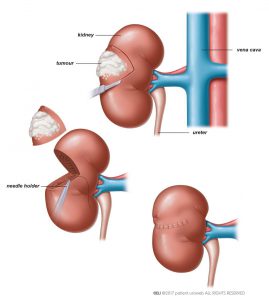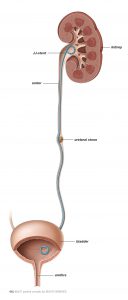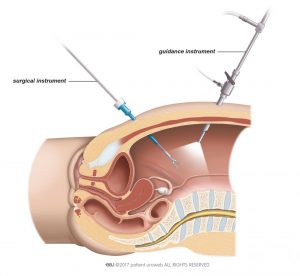Table of Contents
Partial nephrectomy is used to treat kidney cancer that has not spread to other tissue. It is recommended whenever possible. The aim is to remove the part of the kidney with abnormally growing cells (tumour) but to leave as much as possible of the healthy kidney.
How is partial nephrectomy performed?
You will be asleep (general anaesthesia) for partial nephrectomy. You will lie on your side or back during surgery, depending on the location and size of the tumour.
To begin, the exact location of the tumour is determined. Blood flow to the kidney could be temporarily stopped during the surgery to reduce blood loss and to have a better surgical view. This allows for the removal of the entire tumour. Crushed ice is sometimes used to lower the temperature of the kidney during the surgery to prevent damage from lack of blood flow.
After the tumour is removed, the surgeon will sew the wound closed and may apply medicine to stop further bleeding if necessary (Fig. 1).
If the tumour has invaded the collecting system of the kidney, the surgeon may need to place a double-J stent to make sure urine can flow through the urinary system (Fig. 2). The stent will be removed when your wounds have healed and urine flow is back to normal. This can take from several days to weeks.
Surgical approach
Partial nephrectomy can be performed two ways. The operation can be done through a cut in the abdominal wall to reach the kidney and the tumour directly (open surgery). It can also be done with tube-like instruments placed through small cuts to see inside the body (laparoscopic surgery) (Fig. 3). Laparoscopic surgery can also be done assisted by a surgical robot system.
Both techniques are equally effective. Laparoscopic surgery generally leads to faster recovery than open surgery, but the technique is demanding and your doctor needs to have experience doing this type of surgery.
What are the side effects of the procedure?
Usually, you can leave the hospital between 3 and 7 days after surgery. Keep in mind that the length of hospital stay can vary in different countries. After open partial nephrectomy, you may experience some pain on the side of your body for several weeks.
You need to go to your doctor or to the hospital right away if you:
- Develop a fever
- Have blood in the urine
- Have heavy blood loss or pain
What is the impact of the treatment?
Partial nephrectomy is a common procedure for kidney cancer that has not spread. Most patients remain cancer-free up to 5 years after this surgery. The benefit of having two functioning kidneys after surgery contributes to overall kidney function and general health.
What will the follow-up be like?
After partial nephrectomy for kidney cancer, your doctor will plan regular follow-up visits with you. How often these visits are needed depends on analysis of the removed tumour. Follow-up visits continue for at least 5 years. Common tests at follow-up visits are imaging of the abdomen (CT and ultrasound scans), chest x-ray, and urine and blood analyses.




